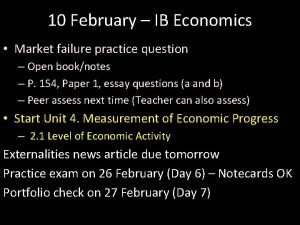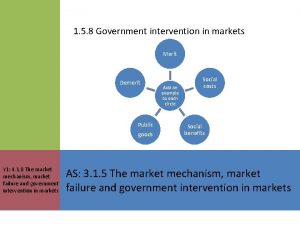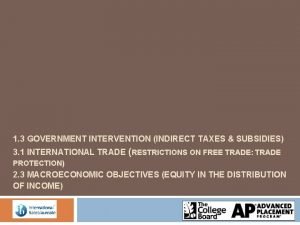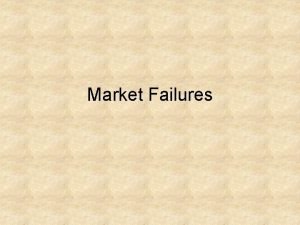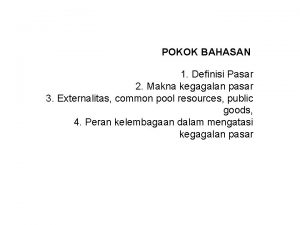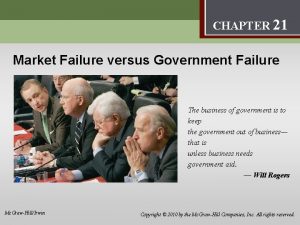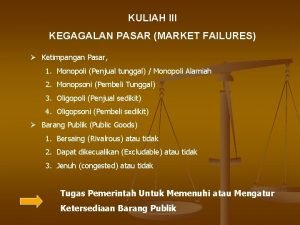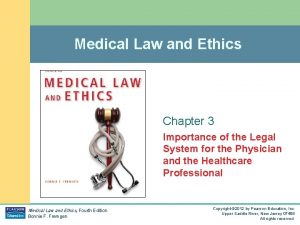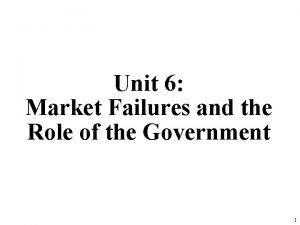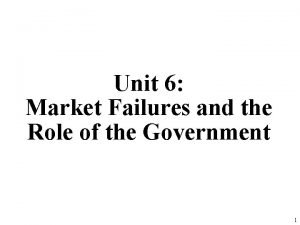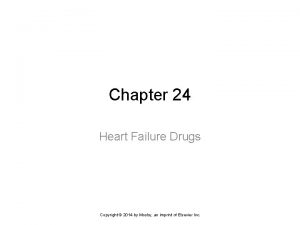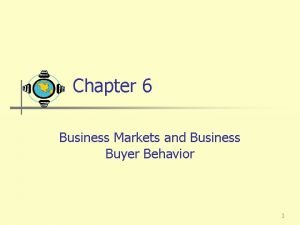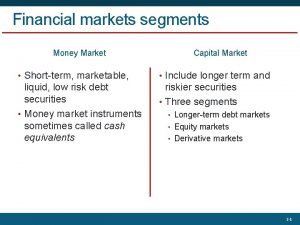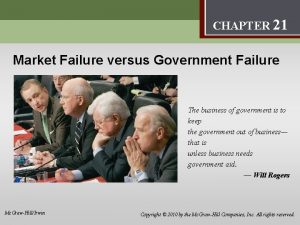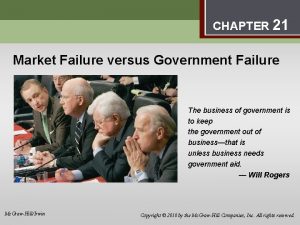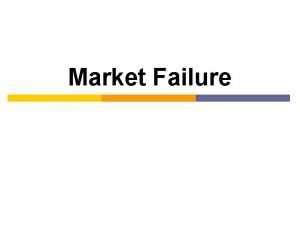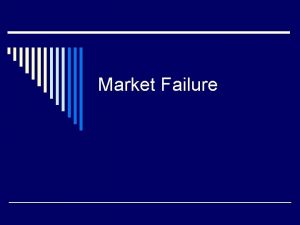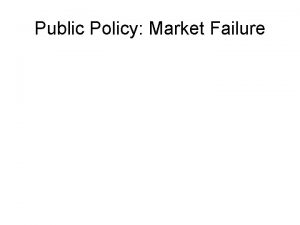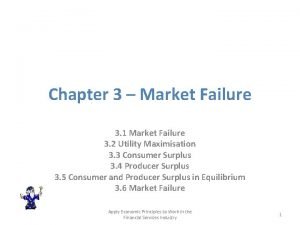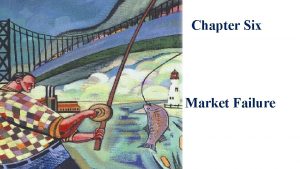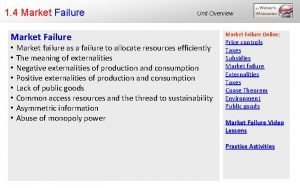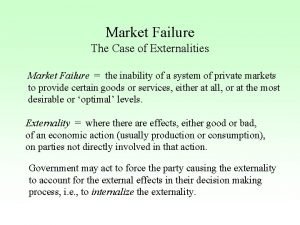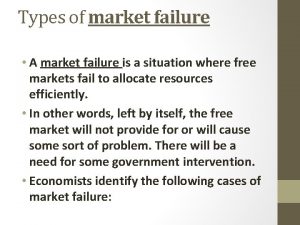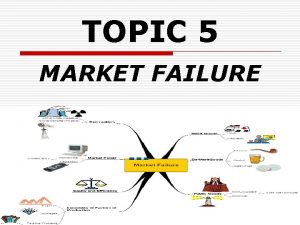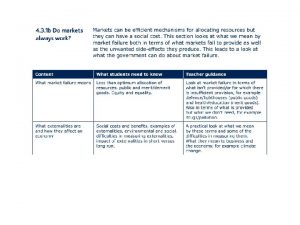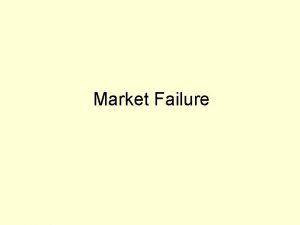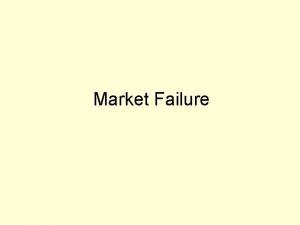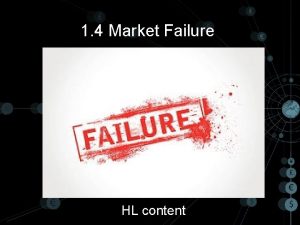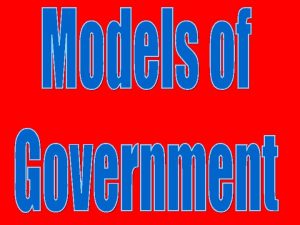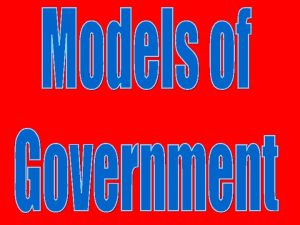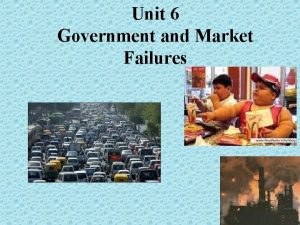Market Failure versus Government Failure 21 CHAPTER 21




























- Slides: 28

Market Failure versus Government Failure 21 CHAPTER 21 Market Failure versus Government Failure The business of government is to keep the government out of business— that is unless business needs government aid. — Will Rogers Mc. Graw-Hill/Irwin Copyright © 2010 by the Mc. Graw-Hill Companies, Inc. All rights reserved.

Market Failure versus Government Failure 21 Chapter Goals • Explain what an externality is and show it affects the market outcome • Describe three methods of dealing with externalities • Define public good and explain the problem with determining the value of a public good to society • Explain how informational problems can lead to market failure • Discuss five reasons why a government’s solution to a market failure could worsen the situation 21 -2

Market Failure versus Government Failure 21 Market Failures • A market failure is a situation in which the invisible hand pushes in such a way that individual decisions do not lead to socially desirable outcomes • Externalities • Public goods • Imperfect information • Government failures are when the government intervention actually makes the situation worse 21 -3

Market Failure versus Government Failure 21 Externalities • Externalities are the effects of a decision on a third party that are not taken into account by the decision-maker • Negative externalities occur when the effects are detrimental to others • Ex. Second-hand smoke and carbon monoxide emissions • Positive externalities occur when the effects are beneficial to others • Ex. Education 21 -4

Market Failure versus Government Failure 21 A Negative Externality Example • When there are negative externalities, the marginal social cost differs from the marginal private cost • The marginal social cost includes the marginal private costs of production plus the cost of negative externalities associated with that production • It includes all the marginal costs that society bears 21 -5

Market Failure versus Government Failure 21 A Negative Externality Example Cost, P S 1 = Marginal If there are no externalities, P 0 Q 0 is the equilibrium Social Cost S 0 = Marginal Private Cost P 1 Cost of externality P 0 D = Marginal Social Benefit Q 1 Q 0 Q If there are externalities, the marginal social cost differs from the marginal private cost, and P 0 is too low and Q 0 is too high to maximize social welfare Government intervention may be necessary to reduce production 21 -6

Market Failure versus Government Failure 21 A Positive Externality Example • When there are positive externalities, the marginal social benefit differs from the marginal private benefit • The marginal social benefit includes the marginal private benefit of consumption plus the benefits of positive externalities resulting from consuming that good • It includes all the marginal benefits that society receives 21 -7

Market Failure versus Government Failure 21 A Positive Externality Example If there are no externalities, P 0 Q 0 is the equilibrium Cost, P S = Marginal Private Cost P 1 Benefit of externality P 0 D 1 = Marginal Social Benefit D 0 = Marginal Private Benefit Q 0 Q 1 Q If there are externalities, the marginal social benefit differs from the marginal private benefit, and both P 0 and Q 0 are too low to maximize social welfare Government intervention may be necessary to increase consumption 21 -8

Market Failure versus Government Failure 21 Methods of Dealing with Externalities • Direct regulation is when the government directly limits the amount of a good people are allowed to use • Incentive policies • Tax incentives are programs using a tax to create incentives for individuals to structure their activities in a way that is consistent with the desired ends • Market incentives are plans requiring market participants to certify that they have reduced total consumption by a certain amount • Voluntary solutions 21 -9

Market Failure versus Government Failure 21 Tax Incentive Policies Cost, P S 1 = Marginal Social Cost S 0 = Marginal Private Cost P 1 P 0 Efficient tax D = Marginal A tax on pollution that equals the social cost of the negative externality will cause individuals to reduce the quantity of the pollution causing activity to the socially optimal level Q 1 Effluent fees are charges imposed by governments on the level of pollution created Social Benefit Q 1 Q 0 Q 21 -10

Market Failure versus Government Failure 21 Market Incentive Policies • A market incentive plan is similar to direct regulation in that the amount of the good consumed is reduced • A market incentive plan differs from direct regulation because individuals who reduce consumption by more than the required amount receive marketable certificates that can be sold to others • Incentive policies are more efficient than direct regulatory policies 21 -11

Market Failure versus Government Failure 21 Voluntary Reductions • Voluntary reductions allow individuals to choose whether to follow what is socially optimal or what is privately optimal • The socially conscious will often become discouraged and quit contributing when they believe a large number of people are free riding • Free rider problem is individuals’ unwillingness to share the cost of a public good 21 -12

Market Failure versus Government Failure 21 The Optimal Policy • An optimal policy is one in which the marginal cost of undertaking the policy equals the marginal benefit of that policy • Resources are being wasted if a policy isn’t optimal • For example, the optimal level of pollution is not zero pollution, but the amount where the marginal benefit of reducing pollution equals the marginal cost 21 -13

Market Failure versus Government Failure 21 Public Goods • A public good is nonexclusive and nonrival • Nonexclusive: no one can be excluded from its benefits • Nonrival: consumption by one does not preclude consumption by others • Many goods provided by the government have public good aspects to them • There are no pure public goods; national defense is the closest example 21 -14

Market Failure versus Government Failure 21 Public Goods • A private good is only supplied to the individual who bought it • Once a pure public good is supplied to one individual, it is simultaneously supplied to all • In the case of a public good, the social benefit of a public good (its demand curve) is the sum of the individual benefits (value on the vertical axis) • To create market demand, • private goods: sum demand curves horizontally • public goods: sum demand curves vertically 21 -15

Market Failure versus Government Failure 21 The Market Value of a Public Good Price $1. 20 A public good is enjoyed by many people without diminishing in value $1. 10 $1. 00 Individual A’s demand is vertically summed with… $0. 80 $0. 60 Market Demand $0. 40 Individual B’s demand to equal… Demand B $0. 60 $0. 50 $0. 20 1 2 3 Demand A Quantity Market demand for a public good 21 -16

Market Failure versus Government Failure 21 Excludability and the Costs of Pricing • The public/private good differentiation is seldom clear-cut • Some economists prefer to classify goods according to their degree of rivalry and excludability Degree of Rivalry in Consumption Rival Non. Rival 100% Apple Encoded radio broadcast Degree of Excludability 0% Fish in ocean General R&D 21 -17

Market Failure versus Government Failure 21 Informational Problems • Perfectly competitive markets assume perfect information • In the real world, buyers and sellers do not usually have equal information, and imperfect information can be a cause of a market failure • An adverse selection problem is a problem that occurs when buyers and sellers have different amounts of information about the good for sale 21 -18

Market Failure versus Government Failure 21 Informational Problems • Signaling may offset information problems • Signaling refers to an action taken by an informed party that reveals information to an uninformed party that offsets the false signal that caused the adverse selection in the first place • Selling a used car may provide a false signal to the buyer that the car is a lemon • The false signal can be offset by a warranty 21 -19

Market Failure versus Government Failure 21 Policies to Deal with Informational Problems • Regulate the market and see that individuals provide the correct information • License individuals in the market and require them to provide full information about the good being sold • Allow markets to develop to provide information that people need and will buy 21 -20

Market Failure versus Government Failure 21 Policies to Deal with Informational Problems Application: Licensing of Doctors • Medical care is an example of imperfect information, patients usually don’t have a way of knowing if a doctor is capable • Current practice is to require medical licenses to establish a minimum level of competency • Another option is to provide the public with information on: • Grades in medical school • Success rate for various procedures • Charges and fees • References 21 -21

Market Failure versus Government Failure 21 Government Failures and Market Failures • All real-world markets in some way fail • Market failures should not automatically call for government intervention because governments fail, too • Government failure occurs when the government intervention in the market to improve the market failure actually makes the situation worse 21 -22

Market Failure versus Government Failure 21 Reasons for Government Failures 1. Government doesn’t have an incentive to correct the problem 2. Government doesn’t have enough information to deal with the problem 3. Intervention in markets is almost always more complicated than it initially seems 4. The bureaucratic nature of government intervention does not allow fine-tuning 5. Government intervention leads to more government intervention 21 -23

Market Failure versus Government Failure 21 Chapter Summary • Three sources of market failure are externalities, public goods, and imperfect information • An externality is the effect of a decision on a third party that is not taken into account by the decision maker • Positive externalities provide third-party benefits and markets for these goods produce too little for too great a price • Negative externalities impose third-party costs, and markets produce too much for too low a price 21 -24

Market Failure versus Government Failure 21 Chapter Summary • Economists generally prefer incentive-based programs, such as a tax on the producer of a good with a negative externality, because incentive-based programs are more efficient than direct regulation or voluntary solutions • Voluntary solutions are difficult to maintain because people have an incentive to be free riders • An optimal policy is one in which the marginal benefit of the undertaking equals its marginal cost 21 -25

Market Failure versus Government Failure 21 Chapter Summary • Public goods are nonexclusive and nonrival • Theoretically the market value of a public good can be calculated by summing the value that each individual places on every quantity • Adverse selection occurs when buyers or sellers withhold information causing the market for the good to disappear • Licensure and full disclosure are solutions to the information problem 21 -26

Market Failure versus Government Failure 21 Chapter Summary • Government failure, in which intervention worsens the problem, occurs because: • Governments don’t have incentives and/or information to correct the problem • Intervention is more complicated than it initially seems • The bureaucratic nature of government precludes fine-tuning • Government intervention leads to more government intervention 21 -27

Market Failure versus Government Failure 21 Preview of Chapter 22: Behavioral Economics and Modern Economic Policy • Define mechanism design and summarize its relationship to behavioral economics • Define nudge and choice architecture and explain how they are related to behavioral economic policy • Explain why a nudge policy meets a libertarian paternalism criterion • Describe three types of choices where nudges can be useful • State two types of nudge policy • Distinguish between nudge and push policies • Discuss the concerns many traditional economists have about nudge and push policies 21 -28
 Role of government in correcting market failure
Role of government in correcting market failure Example of negative externality
Example of negative externality Failure to sense
Failure to sense Failure to sense
Failure to sense Cup and cone fracture ductile or brittle
Cup and cone fracture ductile or brittle Market follower
Market follower Market segmentation market targeting and market positioning
Market segmentation market targeting and market positioning What are the three levels of government
What are the three levels of government Define market failures
Define market failures Market failure definition ib
Market failure definition ib Indirect tax to correct market failure
Indirect tax to correct market failure Indirect tax graph
Indirect tax graph Market failure quiz
Market failure quiz Market failures
Market failures Types of market failure
Types of market failure Pengertian market failure
Pengertian market failure Market failure examples
Market failure examples Kegagalan pasar
Kegagalan pasar Importance of medical law
Importance of medical law Unit 6 four market failures
Unit 6 four market failures Governments can sometimes improve market outcomes examples
Governments can sometimes improve market outcomes examples Unit 6 market failures and the role of the government
Unit 6 market failures and the role of the government Chapter 24 heart failure drugs
Chapter 24 heart failure drugs Teaching market structures with a competitive gum market
Teaching market structures with a competitive gum market Market forms of poultry with pictures
Market forms of poultry with pictures Primary target market and secondary target market
Primary target market and secondary target market 6 markets model
6 markets model Space market in real estate
Space market in real estate Money market and capital market
Money market and capital market









